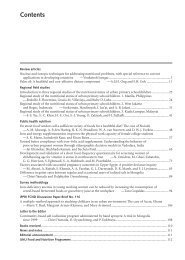From Invisible to Visible - Positive Deviance Initiative
From Invisible to Visible - Positive Deviance Initiative
From Invisible to Visible - Positive Deviance Initiative
You also want an ePaper? Increase the reach of your titles
YUMPU automatically turns print PDFs into web optimized ePapers that Google loves.
igorous hand-washing and scrubbing procedure<br />
in the doc<strong>to</strong>r’s ward, most notably with chlorideof-lime<br />
solutions, a powerful antiseptic.<br />
Infections dropped precipi<strong>to</strong>usly—from 17 percent<br />
of all patients <strong>to</strong> one percent.<br />
Despite this scientific knowledge, compliance<br />
with hand hygiene pro<strong>to</strong>cols among most healthcare<br />
workers remains less than 50 percent.<br />
Gowns, gloves, and consistent hand hygiene are<br />
often viewed as a time consuming nuisance. The<br />
insight that knowledge does not change behavior<br />
was the reason why Billings Clinic was paying<br />
more and more attention <strong>to</strong> addressing the “how”<br />
of behavior change. The “how” was <strong>Positive</strong><br />
<strong>Deviance</strong>.<br />
Nick Wolter sent Nancy Iversen, the direc<strong>to</strong>r of<br />
patient safety, <strong>to</strong> a workshop on <strong>Positive</strong><br />
<strong>Deviance</strong>, conducted by Jerry and Monique<br />
Sternin, in Bos<strong>to</strong>n in July 2005. Ms. Iversen,<br />
inspired by how people at Waterbury Hospital in<br />
Connecticut had achieved early success with<br />
using PD for medication reconciliation, was eager<br />
<strong>to</strong> start PD at Billings Clinic.<br />
The next year, Billings Clinic became one of the<br />
six beta site healthcare systems that <strong>to</strong>ok part in a<br />
Plexus Institute-led MRSA Prevention<br />
Partnership xix . These beta sites agreed <strong>to</strong> tackle<br />
MRSA as a behavioral and social problem using<br />
<strong>Positive</strong> <strong>Deviance</strong> as the driving approach. In late<br />
summer 2006, a Billings Clinic team led by Ms.<br />
Iversen, visited the Veterans Health<br />
Administration Pittsburgh Healthcare System<br />
(VAPHS), a sister beta site that had implemented<br />
PD some months previously, and had some lessons<br />
<strong>to</strong> share xx .<br />
In spring 2006, the Plexus team that included<br />
Jerry and Monique Sternin and Keith McCandless<br />
had come <strong>to</strong> Billings Clinic for the PD MRSA<br />
kick-off event. The Sternins’ visit generated both<br />
enthusiasm and skepticism. However, with CEO<br />
Nick Wolter’s backing, and Billings Clinic’s commitment<br />
<strong>to</strong> be a beta site partner on the Plexus<br />
Institute-led MRSA Prevention Partnership, the<br />
PD process began <strong>to</strong> roll.<br />
Keith McCandless and Joelle Everett, two highly<br />
accomplished organizational change consultants,<br />
and Monique Sternin, were coaches for the<br />
Billings PD MRSA initiative. Just the after the<br />
kickoff event staff who were interested in working<br />
on s<strong>to</strong>pping MRSA infections met <strong>to</strong> begin.<br />
As 2006 was coming <strong>to</strong> a close, Billings Clinic had<br />
initiated a concerted MRSA prevention program<br />
consisting of active surveillance, culturing of<br />
patients admitted <strong>to</strong> the Intensive Care Unit<br />
(ICU), contact precautions for any patient in the<br />
hospital known <strong>to</strong> be colonized or infected with<br />
MRSA, hand hygiene, and hospital-wide implementation<br />
of the <strong>Positive</strong> <strong>Deviance</strong> approach <strong>to</strong><br />
improve adherence <strong>to</strong> infection control practices.<br />
The first step at Billings Clinic was a rigorous<br />
effort <strong>to</strong> get a baseline on MRSA prevalence. A<br />
prevalence study on all hospital patients and 300<br />
volunteer healthcare workers was conducted in<br />
the fall of 2006. The MRSA prevalence rates for<br />
patients at Billings Clinic were in line with<br />
national averages: just under eight percent for<br />
Coaches Joelle Everett (left) and Keith McCandless<br />
(center) Carlos Arce, direc<strong>to</strong>r, organizational and<br />
leadership development at Billings Clinic<br />
11

















